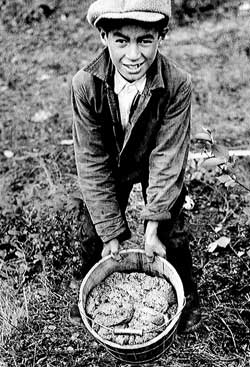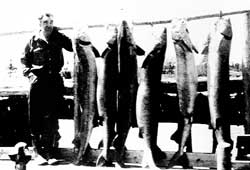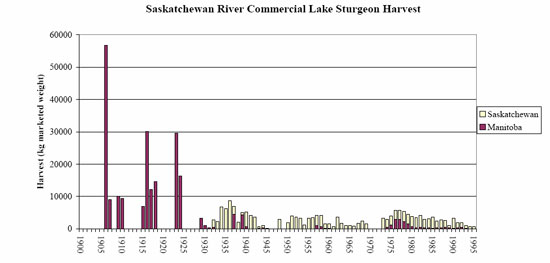Fisheries
Commercial
- Through the 1800s the desire for caviar (sturgeon eggs), isinglass (gelatin extracted from the swim bladder and used as a clarifying agent and glue) and smoked sturgeon meat in Europe and elsewhere in North America increased and more southern sturgeon stocks were fished out.
- As the value of sturgeon began to rise a commercial lake sturgeon fishery was established on the Saskatchewan River in 1898.
- The commercial fisheries for sturgeon grew rapidly in North America, and by the mid-1900s most North American lake sturgeon populations had become depleted as over-harvesting to meet the demand for caviar in Europe drastically reduced the numbers of sturgeon, particularly reproducing females.
- Harvests from the Saskatchewan River were high (up to 56,000 kg/year) for the first three decades, then plummeted to less than 1000 kg/year by 1930.
- Through the following decades the Saskatchewan River sturgeon fishery was closed several times due to low harvests. It has now been closed since 1995 in Manitoba and 1996 in Saskatchewan.



Harvests reported from Manitoba prior to 1930 are thought to include harvests of sturgeon from both Manitoba and Saskatchewan portions of the river.
Sport
- Sport fishing for lake sturgeon in the Saskatchewan River near Cumberland House and The Pas has never been very popular and the harvest has been insignificant relative to the commercial harvest.
- Still, due to depleted stocks in both provinces, the possession limit for sturgeon caught by sport fishing anywhere in Manitoba and Saskatchewan was decreased from one to zero in 1995 and 1999 in each province respectively.
First Nations
- The only remaining legal harvest of lake sturgeon in the Saskatchewan River in Saskatchewan and Manitoba is the Aboriginal domestic fishery.
- In order to properly manage and rehabilitate the sturgeon population an estimate of the domestic harvest is needed. Therefore, in 2001 and 2002, the SRSMB conducted harvest surveys at The Pas and Cumberland House. At least 74, and as many as 319 sturgeon were harvested in each year.
- The SRSMB recognizes domestic harvest as an important component of traditional lifestyles and wants to see harvests continue into the future. However, the Board also recognizes that the domestic harvest may be one of the key factors now limiting the population. Based on current estimates of populations and harvests the board encourages domestic fishers to voluntarily reduce sturgeon harvest.